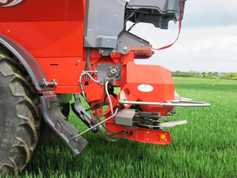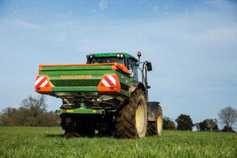Given that Northern Ireland has decided to abolish all Single Farm Payment (SFP) entitlements in 2014 and start again with new entitlements established in 2015, it has caused a lot of turmoil in the conacre market.
The changes have left many productive farm businesses with little option but to downsize their enterprises, with land owners deciding to take back land in 2015 and start farming again to stay within active farmer rules.
Among those hardest hit are potato and vegetable growers who generally have a high reliance on conacre land. One specialist potato grower, who contacted the Irish Farmers Journal, said that he is selling some of his harvesting equipment this winter as he has been unable to secure the majority of his conacre land in 2015. “I can’t afford to let the machinery lie around for a year doing nothing. I have got to look for other opportunities now,” he said.
It is understandable that someone who normally leases part of their holding for potatoes or vegetables has taken the decision to hold on to all of their land this year and establish new entitlements over the whole area. The current direction of travel will mean a flat-rate payment of approximately €329/ha by 2021. It is a system that could last well into the next decade, so the number of entitlements established in 2015 is important.
However, that does not mean that farmers and growers cannot come to an agreement in 2015 that would still involve some land being given up by the farmer for crops grown by someone else. For an agreement to be reached, some trust is required from both parties. However, the final outcome can be fair to both.
There are two options worth considering. In all scenarios, it is assumed that both parties meet the requirement to be an active farmer to claim subsidy payments.
The simpler option is that the farmer and the grower decide to swap land in 2015. For example, the grower plants 3ha of the farmers’ land in potatoes. In return, the grower gives the farmer 3ha of land which is currently in grass. In practice, it probably only works if both parties are close neighbours – remember, the person establishing entitlements this year must be the person who is actively farming the land. But because land and individual entitlements are not linked together, it would be simply a matter of swapping over field numbers again on the Single Application Form (SAF) in 2016.
The other option is more complicated and would involve the transfer of entitlements in 2016. But it can be made to work where there is willingness from both parties, and can be done in such a way that is cost neutral. The key is that all payment entitlements will be worth the same by 2021, so if entitlements change hands, the money to be paid would reflect the effect of the trade as far as 2021.
Example
To illustrate the point, the example shown below involves a farmer with 80ha of eligible land. The total initial value of their subsidy in 2015 is €40,000. Assuming they put all 80ha of land on the SAF in 2015, they will have a starting point of €500.
The other party in the potential deal is a potato grower with 40ha of eligible land, and an initial starting point in 2015 of €10,000. If they put all 40ha on the SAF in 2015, the entitlements would start at €250 each.
The potato grower normally takes 3ha of land from the farmer each year. They agree the same in 2015 – it means that the grower now has 43 entitlements on the 2015 SAF, with an initial value of €233, while the farmer has 77 entitlements with an initial value of €520.
In 2016, the potato grower transfers three entitlements back to the farmer. By then, these entitlements are worth €260 each – they have moved two steps of seven towards the flat-rate payment of €329 by 2021.
Shown in Table 1 is the total subsidy payment for the farmer from 2015 to 2021. In scenario one, there is no deal done – it is based on 80 entitlements with an initial value of €500 each. In scenario two, a total of 77 entitlements are established in 2015. In 2016, the three entitlements are transferred into the business, taking the total to 80.
Across the seven years to 2021, the farmer would draw down a total of €225,349 in scenario one. In scenario two, the total realised is slightly higher at €226,752. In the example shown, the farmer owes the potato grower a total of €1,403 which works out as €468/ha, or €189 per acre. That would leave the potato grower with a total subsidy income of €82,620, which is the same as if they had just established 40ha and did no deal with the farmer.
Value
The money to be paid to either party is dependent on the value of entitlements held by each business. In Table 2, it is the potato grower who holds 80 entitlements worth €500 and the farmer who holds 40 entitlements worth €250.
In scenario one, no agreement is reached and over the seven-year period to 2021, the farmer has a total subsidy payment of €82,620. In scenario two, he allows the potato grower to plant 3ha of his land in 2015. The grower establishes entitlements over this land and transfers three entitlements back to the farmer in 2016. By then, each of these entitlements is worth €438.
Under this second scenario, the farmer has total subsidy payments of €85,588 from 2015 to 2021. They are €2,968 better off under scenario two, which when spread across 3ha equates to €989/ha or €400/acre. This is the money owed to the grower as part of the conacre arrangement.
Calculate
The actual figures used in the two examples are not that relevant. The main point to note is that it will be possible later this year to calculate just what payment will be required if a potato or vegetable grower enters into an agreement with a livestock farmer to grow crops this year and transfer back the entitlements in 2016.
It could be done by an independent party, who will need to know the starting point in 2015 for entitlement values within each business, the area leased out and the number of entitlements to be transferred back in 2016. The amount can then be added or deducted from the agreed 2015 conacre price.
Given the high conacre prices on offer from some potato growers this year, a small number of farmers have agreed to let their land in potatoes this year without transferring back entitlements at a later date. By 2021, each acre of land will have drawn down around £400/acre of subsidy which, in some cases, is less than the conacre prices being discussed.
Farmer queries value of subsidy payment
A farmer who contacted the Irish Farmers Journal has said that he entered an agreement with a neighbouring farmer to hand over the total value of the subsidy over the next five years, along with the conacre rent. He has queried how much money will be involved in the transaction.
Both parties are active farmers, and eligible to establish entitlements this year. Therefore, the farmer who is renting out some of his land will establish his 2014 payment over a lesser area in 2015. His neighbour normally takes 30 acres and is keen to do so again this year.
In 2015, each additional hectare of land on the SAF is worth approximately €46.96/ha in subsidy, rising to €329/ha in seven equal steps to 2021 (2016 – €93.94/ha; 2017 – €140.92; 2018 – €187.91; 2019 – 234.89; 2020 – €281.85/ha; 2021 – €329/ha). The exact values will not be known until later this year when an accurate figure for the NI average is calculated – the €329/ha figure is a best estimate.






 This is a subscriber-only article
This is a subscriber-only article










SHARING OPTIONS: